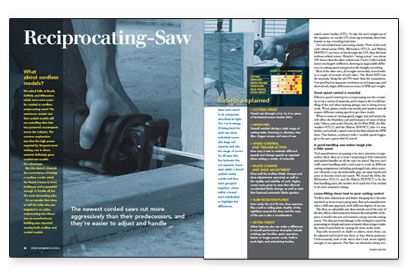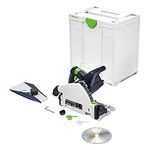Reciprocating-Saw Showdown
The newest corded saws cut more aggressively than their predecessors, and they're easier to adjust and handle.

Synopsis: Reciprocating saws (the Sawzall is a popular model) are well known for their ability to cut through just about anything and still beg for more work. Whether you need a reciprocating saw with lots of power or a model that’s light enough to lug onto a roof, contributing editors Rick Arnold and Mike Guertin help you pick the best saw for any job. The new-generation ”cip saws feature some innovative improvements. Our experts rate each saw’s cutting performance, handling, speed control, trigger action, blade changing, shoe adjustments, blade sightlines, and maneuverability. There’s also a sidebar on cordless reciprocating saws.
Not many tools take as much abuse as a reciprocating saw. Right out of the box, your saw is likely to get dirty and stay that way.
Carpenters, remodelers, plumbers, and electricians all rely on this saw to perform tasks that other tools can’t. Whether you have to hog through studs during demolition, perform surgery on a hardwood floor, or do anything in between, you’ll be reaching for the tool that Milwaukee named Sawzall over 50 years ago.
Not your old reciprocating saw
For this review, we tested 14 different 9-amp to 13-amp saws priced from $90 to $270 on job sites and in the shop. This new group of reciprocating saws offers features you wouldn’t have found on premium-priced models 15 years ago: tool-less blade change and nosepiece adjustment, improved vibration control, and faster cutting speed, just for starters. Even the lowest-priced saws in this test are a major step up from the best 15-year-old saw in our collection. Because these tools have a broad price range and a wide range of performance priorities, we set out to take a closer look at the best new reciprocating saws.
Orbital action gives a cut above the rest
Cutting with a reciprocating saw is usually about speed, and cut speed is a function of SPM (strokes per minute), stroke length, and stroke geometry. All the tools in our test had a stroke of 1 1⁄8in. to 1 1⁄4in., and SPM topped out in the 2800 to 2900 range.
The Milwaukee, Hilti, Makita, Porter-Cable, and Hitachi models feature orbital action (Hitachi calls it “swing action”) designed to increase cutting speed. Typically selected with a switch or a rotating dial, this setting makes the cutting action more aggressive by adding an up-and-down motion to the blade’s standard reciprocating motion. Orbital action isn’t recommended when cutting steel or when precise cuts are desired.
We cut a variety of different materials to evaluate each saw’s overall cutting performance. To test cutting speed, we made timed cuts through a 6-in. by 6-in. piece of laminated-veneer lumber (LVL). To take the saw’s weight out of the equation, we cut the LVL from top to bottom, then from bottom to top, recording total time.
Our test yielded some interesting results. Three of the tools with orbital action (Hilti, Milwaukee 6523-21, and Makita JR3070CT) cut twice as fast through the LVL than did tools without orbital action. Hitachi’s “swing action” was about 10% slower than the other orbital tools. Porter-Cable’s orbital action was largely ineffective, showing no appreciable difference in cutting speed compared to the straight-cut setting.
For more photos, charts, and details, click the View PDF button below:
Fine Homebuilding Recommended Products
Fine Homebuilding receives a commission for items purchased through links on this site, including Amazon Associates and other affiliate advertising programs.

The New Carbon Architecture: Building to Cool the Climate

Festool Cordless Track Saw (TSC 55 KeB-F)

Code Check 10th Edition: An Illustrated Guide to Building a Safe House






















